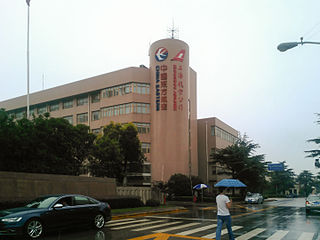
KLM Royal Dutch Airlines, legally Koninklijke Luchtvaart Maatschappij N.V., is the flag carrier of the Netherlands. KLM is headquartered in Amstelveen, with its hub at nearby Amsterdam Airport Schiphol. It is a subsidiary of the Air France–KLM group and a member of the SkyTeam airline alliance. Founded in 1919, KLM is the oldest operating airline in the world, and has 35,488 employees with a fleet of 110 as of 2021. KLM operates scheduled passenger and cargo services to 145 destinations.
Air New Zealand Limited is the flag carrier airline of New Zealand. Based in Auckland, the airline operates scheduled passenger flights to 20 domestic and 30 international destinations in 18 countries, primarily around and within the Pacific Rim. The airline has been a member of the Star Alliance since 1999.

Emirates is one of two flag carriers of the United Arab Emirates. Based in Garhoud, Dubai, the airline is a subsidiary of The Emirates Group, which is owned by the government of Dubai's Investment Corporation of Dubai. As of 2019, it was also the largest airline in the Middle East, operating over 3,600 flights per week from its hub at Terminal 3 of Dubai International Airport. It operates to more than 150 cities in 80 countries across all continents through its fleet of nearly 300 aircraft. Cargo activities are undertaken by Emirates SkyCargo.

Singapore Airlines is the flag carrier of the Republic of Singapore with its hub located at Changi Airport, and a member of the Star Alliance. The airline is notable for highlighting the Singapore Girl as its central figure in the corporate branding segment. Widely renowned as one of the best carriers, airline is ranked as a 5-star airline by Skytrax, and it has also been ranked as the world's best airline five times. The airline operates a variety of Boeing and Airbus aircraft, including the A350, 787, 777, A380, and 737.
Garuda Indonesia is the flag carrier of Indonesia, headquartered at Soekarno–Hatta International Airport. A successor of KLM Interinsulair Bedrijf, it is a member of SkyTeam and the second-largest airline of Indonesia after Lion Air, operating scheduled flights to a number of destinations across Asia, Europe, and Australia from its hubs, focus cities, as well as other cities for Hajj. It is the only Indonesian airline that flies to European airspace.
All Nippon Airways Co., Ltd. is an airline of Japan. Headquartered in Minato, Tokyo, ANA operates services to both domestic and international destinations and had more than 20,000 employees as of March 2016. In October 1999, the airline became a member of Star Alliance.

Ansett Australia was a major Australian airline group, based in Melbourne, Victoria. The airline flew domestically within Australia and from the 1990s to destinations in Asia. After operating for 65 years, the airline was placed into administration in 2001 following a financial collapse and subsequent organised liquidation in 2002, subject to deed of company arrangement. The last flight touched down on 5 March 2002.
Air China Limited (中国国际航空公司) is the flag carrier of the People's Republic of China and one of the "Big Three" mainland Chinese airlines. Air China's headquarters are in Shunyi District, Beijing. Air China's flight operations are based primarily at Beijing Capital International Airport. In 2017, the airline carried 102 million domestic and international passengers with an average load factor of 81%. The airline joined Star Alliance in 2007.
Korean Air Lines Co., Ltd., operating as Korean Air, is the flag carrier of South Korea and its largest airline based on fleet size, international destinations, and international flights. It is owned by the Hanjin Group.
Virgin Australia, the trading name of Virgin Australia Airlines Pty Ltd, is an Australia-based airline. It is the largest airline by fleet size to use the Virgin brand. It commenced services on 31 August 2000 as Virgin Blue, with two aircraft on a single route. It suddenly found itself as a major airline in Australia's domestic market after the collapse of Ansett Australia in September 2001. The airline has since grown to directly serve 32 cities in Australia, from hubs in Brisbane, Melbourne and Sydney.
EVA Airways Corporation, of which "EVA" stands for Evergreen Airways, is one of the two largest airlines in Taiwan – the other being China Airlines. It operates passenger and dedicated cargo services to over 40 international destinations in Asia, Australia, Europe, and North America. In contrast to the state-owned flag carrier China Airlines, EVA Air is privately owned and flies a fully international route network with no domestic destinations. It is rated as a 5-star airline by Skytrax, and is the second largest airline based in Taiwan after China Airlines. EVA Air is headquartered at Taoyuan International Airport in Luzhu, Taoyuan City. The company slogan is "Sharing the World, Flying Together".
Transaero, officially OJSC Transaero Airlines was a Russian airline that operated scheduled and charter flights to over 150 domestic and international destinations. Transaero's main hubs were Moscow Vnukovo Airport and Saint Petersburg Airport, with further bases throughout Russia. For much of its history the head office was at Domodedovo International Airport, and towards the end its head office was in Saint Petersburg.

Etihad Airways is one of two flag carriers of the United Arab Emirates, along with Emirates. Its head office is in Khalifa City, Abu Dhabi, near Abu Dhabi International Airport. Etihad commenced operations in November 2003. It is the second-largest airline in the UAE after Emirates. The name Etihad is Arabic for 'Union'.
OJSC Turkmenistan Airlines is the flag carrier and only airline of Turkmenistan, headquartered in Ashgabat. It operates domestic and international passenger and cargo services mainly from its hub at Ashgabat International Airport.

China Eastern Airlines Corporation Limited is an airline headquartered in the China Eastern Airlines Building, on the grounds of Shanghai Hongqiao International Airport in Changning, Shanghai, China. It is one of the "Big Three" airlines of the People's Republic of China, operating international, domestic and regional routes. China Eastern's main hubs are Shanghai Pudong Airport and Hongqiao Airport.
Singapore Airlines operates a predominantly widebody fleet, until the second re-introduction of the Boeing 737 in March 2021 following the merger with SilkAir. The airline also operates Boeing 747-400F and Boeing 777F freighters. As of December 2023, there were 161 aircraft registered in the Singapore Airlines fleet, comprising 149 passenger aircraft and 12 freighters.

Premium economy class, also known by brand names which vary by company, is a travel class offered on many airlines. It is usually positioned between standard economy class and business class in terms of price, comfort, and available amenities. In 1991, EVA Air was the first to introduce Evergreen Class, becoming the first airline to offer this class of service. It was widely acknowledged that the premium economy class has become a standard reflection of what the economy class was like several decades ago. In some countries, this class has emerged as a response from governments and companies requiring economy class for travel done by staff.
Air France, stylised as AIRFRANCE, is the flag carrier of France headquartered in Tremblay-en-France. It is a subsidiary of the Air France–KLM Group and a founding member of the SkyTeam global airline alliance. As of 2013, Air France serves 29 destinations in France and operates worldwide scheduled passenger and cargo services to 201 destinations in 78 countries and also carried 46,803,000 passengers in 2019. The airline's global hub is at Charles de Gaulle Airport with Orly Airport as the primary domestic hub. Air France's corporate headquarters, previously in Montparnasse, Paris, are located at the Roissypôle complex on the grounds of Charles de Gaulle Airport, north of Paris.

First class is a travel class on some passenger airliners intended to be more luxurious than business class, premium economy, and economy class. Originally all planes offered only one class of service, with a second class appearing first in 1955 when TWA introduced two different types of service on its Super Constellations.
The Air New Zealand fleet consists of Boeing jet aircraft for long-haul flights, and Airbus jet aircraft for domestic and short-haul international flights. The airline also operates ATR 72 and Bombardier Q300 turboprop aircraft on domestic services.










